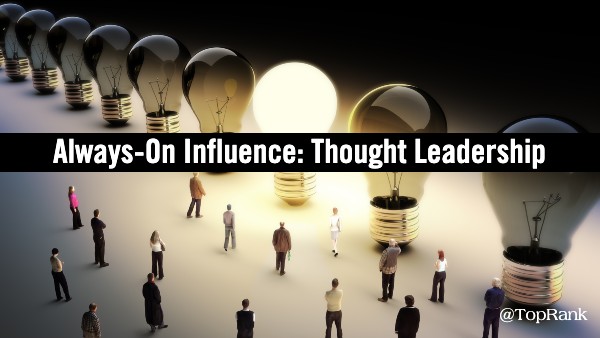
Thought Leadership is often a concept associated with individuals but brands, especially in B2B, can develop their thought leadership amongst the customer community as well. Thought Leadership is important for brands and individuals alike because trust is an issue for companies as people navigate misinformation, changing sources and become more skeptical of what brands and their people say.
What is thought leadership in 2020? Beyond publishing articles, speaking and writing books, Thought Leadership is about creating a reputation for expertise and authority within an industry. The notion is that becoming known for an area of expertise creates trust which can lead to consideration, evaluation and influence purchase behavior.
“Brands that cultivate a culture of Thought Leadership reap greater reputation and sales impact than those that do not”. Edelman LinkedIn B2B Thought Leadership Impact Study
So where do influencers fit in with a brand’s thought leadership?
83% of B2B marketers consider influencer marketing because they want to be seen as thought leaders. TopRank Marketing State of B2B Influencer Marketing Report
In the B2B world, most influencers are thought leaders themselves since domain expertise is really an important part of what makes a business influencer trusted, respected, credible and interesting for others to follow.
B2B brands that want to elevate the thought leadership of their brand through executives can be a part of an Always-On Influencer Marketing program that combines points of view about key topics where both the industry influencer and brand executive are participants. When a brand executive is included in brand content created in collaboration with industry experts and thought leaders, it can start to change the perception of that brand executive to be seen as a thought leader themselves.
Partnering B2B brand executives and subject matter experts with industry influencers for Thought Leadership content provides multiple benefits:
- Diverse voices from the industry and brand add credibility and quality to the content
- The influence of industry experts elevates the influence of the brand executives
- Influencers reputation is raised by association with thought leadership level content and the brand
The beauty of influencer content programs for thought leadership is that when brands build real relationships with industry thought leaders, they become partners that advocate for the brand as well as for the brand executives involved
“Partnering with influencers for thought leadership content can accelerate brand credibility and trust.”
So how can a B2B brand approach an integrated influencer marketing and thought leadership program? Here are 5 steps to start:
1. Define Thought Leadership Topics – The obvious starting point is clarity around how the brand wants to be known that reconciles with what the industry and customers care about. We often call these “best answer” topics because one of the goals of Thought Leadership and Influencer content is for the brand to become the best answer for customers. Defining these topics will drive every other step in the Influencer Marketing and Thought Leadership partnership.
2. Identify Influencers and Executives – Once a B2B brand determines topics of focus, it’s time to connect those topics to the most appropriate and relevant executives who will represent the brand’s thought leadership effort. At the same time, those topics will be used to identify and qualify relevant industry influencer partners to collaborate with. The minimum data points for influencer selection include topical relevance, topic resonance with the influencer’s community, network size, inventory of thought leadership content and experience, values alignment and publishing activities.
3. Create a Thought Leadership Content Collaboration Plan – To create meaningful and impactful Thought Leadership content with B2B brand executives and industry influencers, topics need to be mapped to contributors and content types, formats and channels need to be identified. A content calendar of opportunities is created, often integrating with planned content from marketing campaigns, public relations media relations efforts and corporate communications.
4. Publish and Promote – Collaborations manifest as content that will need a home whether it is the corporate website, blog, social channels, industry publications, research reports, marketing campaign assets, on influencer websites and social channels or in presentation content. Formats run the gamut from text to video to audio to interactive. Influencers and brand social channels alone are not enough for promotion of B2B Thought Leadership content. LinkedIn advertising offers excellent executive targeting capabilities as do other social networks and paid search platforms.
5. Always-On Influencer Engagement for Advocacy – Influencer Marketing is a relationship business and Thought Leadership content co-created with brand executives and influencers can be repurposed, giving influencers continued exposure. Other engagement actions as simple as social media interactions or as robust as future content collaborations provide influencers reason to invest in the success of the content and inspire organic advocacy for their brand executive partners as well as the brand itself.
What does the future of influencer marketing and thought leadership hold? Listen to what Janine Wegner, @JanineWegner Global Thought Leadership Program and Activation Manager at Dell Technologies (client) has to say:
“One of the key things to think about as businesses and academic institutions, is how can we introduce influencer marketing in combination with thought leadership as a key component with the marketing and business suite so people can actually be educated, get accredited or a degree. How does influencer marketing and thought leadership fit within the bigger marketing play and strategy. It’s an integrated part of the marketing play.”
Thought Leadership and Influencer Marketing represent a key partnership that can produce content that drives trust, reputation, reach and engagement – many of which are in short supply and highly valued by business customers.

Comments are Closed